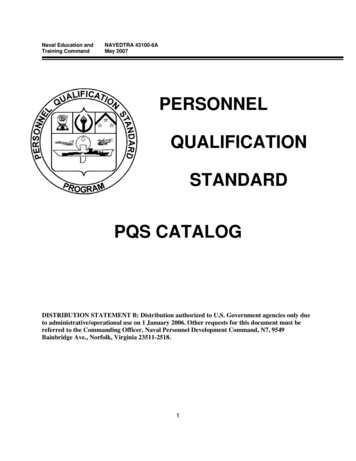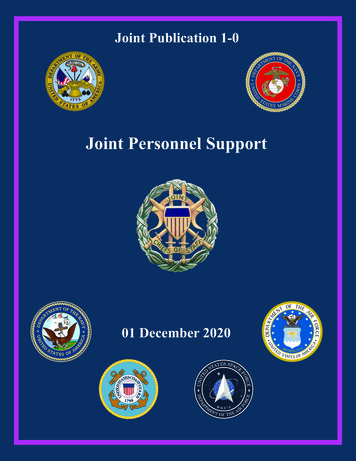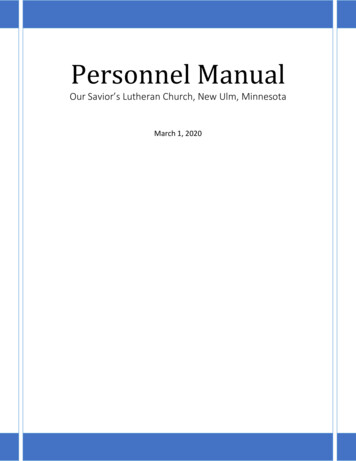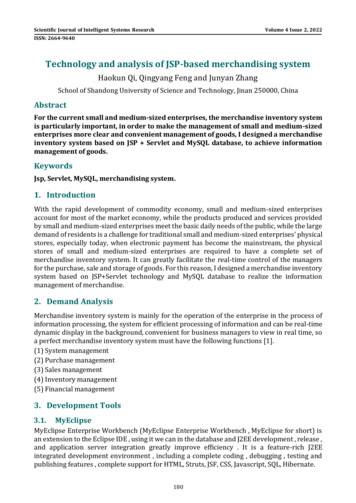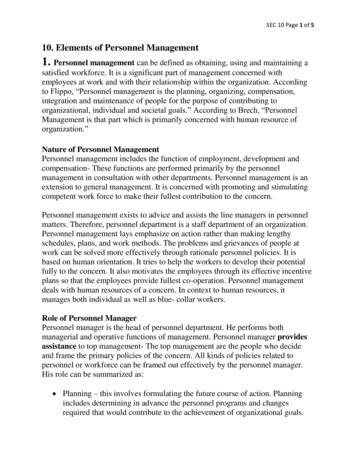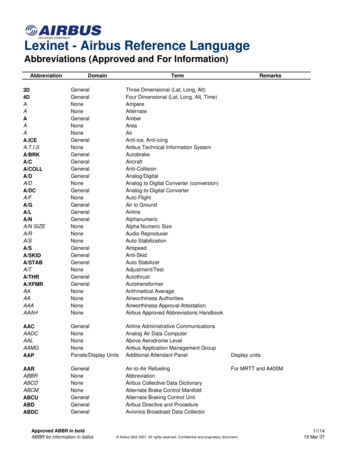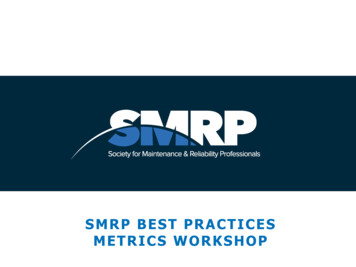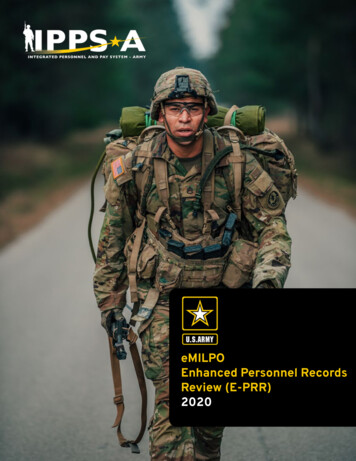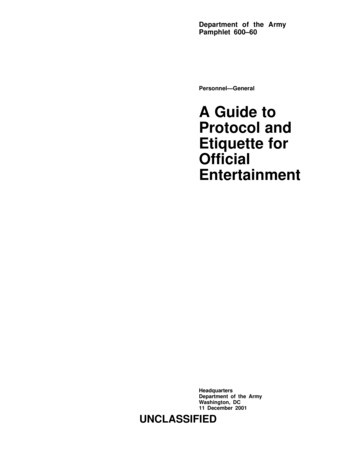
Transcription
Department of the ArmyPamphlet 600–60Personnel—GeneralA Guide toProtocol andEtiquette forOfficialEntertainmentHeadquartersDepartment of the ArmyWashington, DC11 December 2001UNCLASSIFIED
SUMMARY of CHANGEDA PAM 600–60A Guide to Protocol and Etiquette for Official EntertainmentoRewords social calls (chap 1).oDeletes general guidelines in introductions and adds the word "gender" (chap1).oRewords completely engraved invitations (chap 2).oCorrects to state that a printed invitation usually starts with the host of anevent on the first line (chap 2).oAdds that telephone Invitations may be used where there is extremely shortnotice (chap 2).oAdds an explanation of telefax invitations (chap 2).oChanges reply of a married couple to a formal invitation when only one canattend (chap 2).oRemoves informal invitations and corresponding figure (chap 2).oRemoves reference to a sample reception and receiving line checklist (chap3).oChanges reference to carpet at receiving line (chap 3).oAdds guidance regarding a woman standing at the end of the receiving line(chap 3).oClarifies guidance regarding position of receiving line in a room (chap 3).oRemoves guidance of alphabetical flag display (chap 3).oAdds the order of precedence of Service flags (chap 3).oChanges guidance regarding display of personal flags of attendees (chap 3).oRemoves guidance regarding formal dinners and exceptions (chap 3).oAdds guidance regarding an interpreter at a dinner (chap 3).oAdds guidance regarding toasts and prisoners of war (chap 3).oChanges "musical and cannon salutes" title (chap 4).oAdds samples for sequence of events of retirement, award, promotion, andretreat ceremonies (chap 4).
oExpands guidance on finials (chap 4).oChanges guidance regarding streamers facing forward (chap 4).oRevises guidance explaining the need for rules of precedence (chap 5).oRemoves reference to precedence among married, divorced, widowed, andunmarried women (chap 5).oRevises the example of visiting official (chap 5).oConsolidates guidance regarding seating of foreign visitors (chap 5).oClarifies guidance regarding seating and persons on promotion lists (chap 5).oChanges seating of Sergeant Major of the Army to follow that of the Director ofthe Army Staff, a four-star general, or an equivalent rank civilian (chap 5).oAdds table 6-1 titles and forms of address for Vice President, Govenor of aState, warrant officer, and enlisted personnel (chap 6).oChanges the guidance regarding menu restrictions by adding table 7-1 (chap7).oPlaces updated references list in appendix A.oPlaces official toasts in appendix C.oUpdates the precedence list and places it in appendix D.
FOREWORDPractices developed among nations in the course of their contacts with one anotherdefine the essence of protocol. Protocol is the combination of good manners andcommon sense, which allows effective communications between heads of state and theirrepresentatives. It is not static. Rather, it is an evolving science that, over the years, haslost much of its traditional pomp and picturesque ceremony. Changes in acceptedprotocol, however, are best left to the highest policy-forming officers in the Departmentof State. Errors in protocol may be mistaken as a signal of a change in the internationalclimate. Persons using this pamphlet are cautioned that unauthorized innovations inprotocol, however well intentioned, are improper.Etiquette encompasses the body of manners and forms prescribed by custom,usage, or authority. It is accepted as correct behavior when people deal with oneanother. Etiquette preserves respect for the rights and dignities of others. In short,etiquette represents good manners. Today, many of the old established customs areblended with less restricted ways of life—of entertaining with little or no help, incommunicating with others, and in coping with everyday problems that once werehandled by a staff. The full integration of women and divergent cultures into theServices brought more changes. Service people now have a more knowledgeable way oflife. Still, as in bygone years, there are certain rules to be followed in order to reach thegoal of easier, gracious living.As with any rule of the road, a charted course will get you to a specific place at agiven time for a certain occasion. Proper etiquette is not artificial. It is a practical set ofrules. When learned, these rules save time that would be wasted in deciding what isproper. Etiquette helps people proceed with the more important phases of social interaction.The intent of this pamphlet is to provide you with the basics of proper protocol andetiquette. Using this information as a foundation, you should feel at ease in such mattersas calling cards, introductions, invitations and responses, official dinners, seating andprecedence, forms of address, and arranging visits for important visitors. With practice,protocol and etiquette will not be difficult but will be instead a natural, courteous wayto properly greet and entertain civilian and military visitors and colleagues.
*Department of the ArmyPamphlet 600–60HeadquartersDepartment of the ArmyWashington, DC11 December 2001Personnel—GeneralA Guide to Protocol and Etiquette for Official EntertainmentHistory. This informational pamphlet is arevision. The publication was last revisedon 15 October 1989, authenticated byorder of the Secretary of the Army by CarlE. Vuono, General, United States Army,Chief of Staff; Official: William J. MeehanContentsII, Brigadier General, United States Army,The Adjutant General.Summary. This informational pamphletpresents current protocol information.Applicability. This informational pamphlet applies to the Active Army, theArmy National Guard of the UnitedStates, and the United States Army Reserve. During mobilization, procedures inthis publication may be modified by theproponent.Proponent and exception authority.The proponent of this informational pamphlet is the Deputy Chief of Staff of theArmy. The Deputy Chief of Staff of theArmy has the authority to approve exceptions to this pamphlet that are consistentwith controlling law and regulation. Theproponent may delegate the approval authority, in writing, to a division chiefwithin the proponent agency in the gradeof colonel or the civilian equivalent.Suggested Improvements. Those whouse this informational pamphlet are invited to send comments and suggested improvements on DA Form 2028(Recommended Changes to Publicationsand Blank Forms) directly to the DeputyChief of Staff, ATTN: DACS–DSP, 200Army Pentagon, Washington, DC20310–200Distribution. This publication is available in electronic media only and is intended for command levels B, C, D, andE for Active Army, Army National Guardof the United States, and the United StatesArmy Reserve.(Listed by paragraph and page number)Chapter 1Visits and Introductions, page 1Army customs 1–1, page 1General rules 1–2, page 1Official calls 1–3, page 1Social calls 1–4, page 1Introductions 1–5, page 1Chapter 2Invitations, page 1Formal engraved invitations 2–1, page 1Semi-Engraved invitations 2–2, page 2Formal handwritten invitations 2–3, page 3Telephone invitations 2–4, page 3Telefax invitations 2–5, page 3Replies to formal invitations 2–6, page 3Withdrawing an acceptance or invitation 2–7, page 5Informal invitations 2–8, page 5*This pamphlet supersedes DA Pamphlet 600–60, dated 15 October 1989.DA PAM 600–60 11 December 2001UNCLASSIFIEDi
Contents—ContinuedChapter 3Official Entertaining, page 8Army customs 3–1, page 8Formal receptions and receiving lines 3–2, page 8Display of flags at military receptions and dinners 3–3, page 9Seating arrangements 3–4, page 10Formal dinners 3–5, page 11Toasts 3–6, page 12Chapter 4Ceremonies, page 20Rendering honors 4–1, page 20Sequence of events 4–2, page 21Display of flags 4–3, page 22Seating 4–4, page 23Chapter 5Order of Precedence, page 23Determining precedence order 5–1, page 23Individuals frocked to a higher grade 5–2, page 24Individuals on approved promotion lists 5–3, page 24Sergeant Major of the Army 5–4, page 24Retired Army officers 5–5, page 24Chapter 6Forms of Address, page 25Overview 6–1, page 25High officials 6–2, page 25Elected officials 6–3, page 25Use of “His Excellency” 6–4, page 25Distinguished officials 6–5, page 25Chapter 7Arranging Visits for Dignitaries, page 29Planning 7–1, page 29The escort officer 7–2, page 29Entertaining foreign dignitaries 7–3, page 30Chapter 8Guide to Proper Dress, page 32Proper dress for a military or social function 8–1, page 32Tie worn with Army blue and Army white uniforms 8–2, page 32Wear of the Army white uniform 8–3, page 32Equivalent uniforms of Army and other Services 8–4, page 32AppendixesA.References, page 35B.Lists of States and Territories and Date of Entry into the Union, page 36C.Official Toasts, page 37D.Precedence List, page 39Table ListTable 6–1: Titles and forms of address for U.S. officials, page 25Table 7–1: Record of dietary restrictions, page 30iiDA PAM 600–60 11 December 2001
Table8–1: Army uniform/civilian attire, page 338–2: Dress codes, page 338–3: Uniform comparison chart (men), page 338–4: Uniform comparison chart (women), page 34B–1: State and territory dates of entry into the Union, page 36C–1: Official toasts, page 37D–1: Precedence list of civilian and military persons, page 39Figure ��1: Formal engraved invitation, page 22–2: Semi-engraved formal invitation, page 32–3: Formal written invitation, page 42–4: Acceptance of a formal invitation, page 52–5: Regret to a formal invitation, page 62–6: Withdrawal of an acceptance to a formal invitation, page 62–7: Recalling an invitation, page 72–8: Advancing an invitation, page 72–9: Postponing an invitation, page 83–1: Usual mixed dinner, page 133–2: Usual large official dinner, page 143–3: Married couples at mixed dinner, page 143–4: Unmarried couples (No. 5) at mixed dinner, page 153–5: Small mixed dinner (no hostess) (guest of honor and spouse are at No. 2), page 153–6: Small mixed dinner (no hostess), page 163–7: Roundtable seating arrangement, page 163–8: Stag dinner with host and co-host, page 173–9: Stag dinner with no co-host, page 173–10: Another stag dinner arrangement with no co-host, page 183–11: Stag dinner at roundtable with host and co-host, page 183–12: Speaker’s table at a banquet, page 193–13: Sample of a dinner card, page 193–14: Roundtable seating plan, page 203–15: Rectangular or square seating plan, page 20GlossaryDA PAM 600–60 11 December 2001iii
Chapter 1Visits and Introductions1–1. Army customsThe exchange of courtesy visits is one of the Army’s oldest and most established traditions. This is one way soldierscan make social contacts among themselves. These visits, known as official and social calls, are essential to mutualunderstanding, respect, confidence, and teamwork. The size and complexity of today’s Army may hinder the exchangeof courtesy visits. You should follow established customs of the Service whenever possible. Additional sources ofinformation regarding visits, introductions, protocol, and etiquette are listed in appendix A.1–2. General rulesPolicies for making official and social calls differ widely in the various commands and organizations. Such calls arenot made as extensively as in past years. Ask the adjutant, the commander’s aide, or the agency executive officer aboutthe commander’s wishes.1–3. Official callsa. General. All official calls are made at the office of the person visited.b. Arrival calls. Paid by a subordinate to an immediate superior and then on that officer’s superior; for example, anew major to a battalion sets a courtesy call with his or her battalion commander and brigade commander forintroduction. Another method is to have the newcomer escorted to the various offices, introduced to fellow workers,then at a time convenient to superiors, by appointment, courtesy calls are made. Official calls should be made within48 hours after arrival at the new location.c. Departure calls. The official procedures for leaving an installation or post may vary. Custom requires that anofficer departing the post make an official call on his immediate commanding officers as an act of courtesy.1–4. Social callsThe practice of making social calls has declined greatly. The more common practice today is to have a “hail andfarewell” to introduce newcomers and say goodbye to those leaving. However, upon arrival at the new location, oneshould inquire as to which method the commander prefers.a. Making social calls. Some general rules for making social calls:(1) Calls are normally made at the officer’s residence.(2) The visit is planned at a time convenient to the officer visited.(3) If the commander is married and the commander’s spouse is present, the spouse of the officer making the visitshould also attend.(4) Social calls should last no less than 10 minutes and no more than 15 unless the caller is requested to stay longer.b. Commander’s reception. The custom at many installations is for the senior officer to periodically entertainassigned officers and their spouses at a reception or series of receptions.c. New Year’s Day call. It is customary in many organizations for the officers of the unit to call on the commandingofficer on New Year’s Day. One should inquire as to the local policy and how the commander desires to have peoplecall, for example, alphabetical: A–M 1300–1415, M–Z 1430–1545.1–5. IntroductionsBrevity and accuracy are two requirements that must be kept in mind when introducing people. The person making theintroduction is completely in charge of the situation for the length of time that it takes to effect it. There are a fewsimple rules to remember, as shown below.a. A man is always presented to a woman—with the exception of the president of any country, a king, a dignitary ofthe Church, or when a junior female officer is “officially” presented to a senior male officer.b. The honored/higher ranking person’s name is stated first, then the name of the person being presented.c. Young people are presented to older people of the same gender.d. A single person is introduced to a group.Chapter 2Invitations2–1. Formal engraved invitationsa. Engraved invitations (fig 2–1) are the most formal invitation and are issued for very special occasions. They areengraved with black ink on a good quality white or cream colored vellum card stock.DA PAM 600–60 11 December 20011
b. Invitations are sent out 2 or 3 weeks in advance. If the function is extremely large, 3 or 4 weeks may be moresuitable.c. Engraved invitations often include an admittance card to be shown at the door. If admittance or seating cards areenclosed, they should be brought to the function.d. If the party is in honor of a distinguished visitor or other high-ranking official, “the host” is usually the first lineof the invitation, followed by “the event,” then “in honor of,” with the appropriate information on the individual(s) onthe next line or two.2–2. Semi-Engraved invitationsa. Semi-engraved invitations (fig 2–2) are adaptable to any date or occasion and are less expensive. Individuals whomust entertain frequently will generally use these invitations, they are correct for luncheons, receptions, dinners, andretirements.b. Honored guests may be designated by the phrases “in honor of Major General and Mrs. Smith” or “To meetMajor and Mrs. Jones.” The first phrase is more often used for prominent persons; the second, for new arrivals andguests.c. Formerly, it was not considered correct to ask an important official “to meet” anyone of lesser rank. Today,however, most officials may wish to know for whom a party is given, possibly influencing his or her acceptance.Figure 2–1. Formal engraved invitation2DA PAM 600–60 11 December 2001
Figure 2–2. Semi-engraved formal invitation2–3. Formal handwritten invitationsFormal invitations may be hand-written (fig 2–3) on white or cream note paper in black ink. The wording and spacingused on the formal engraved invitation (fig 2–1) are followed. Often the host or hostess has a preference forhandwritten invitations. They are more personal and a nice touch if the size of the party does not make preparing themburdensome.2–4. Telephone invitationsa. Telephone invitations are correct for formal functions as well as for small affairs. They also can be used in a casewhere there is extreme short notice. The protocol officer, aide-de-camp, or secretary could make the calls.b. To confirm oral invitations, reminder cards are frequently sent out to those who have accepted. The engraved,semi-engraved, or handwritten invitations may be used. Draw through the R.S.V.P. and telephone number, writing thewords “To Remind” underneath. Or have the words “To Remind” printed on the invitation where the R.S.V.P. wouldnormally be written.2–5. Telefax invitationsInvitations may be extended by facsimile, especially in a case where time is limited. The fax should include the sameinformation as the invitation above. The facsimile is also a tool to use to notify the invitee of a future event. This waythe date and time can be “saved” months ahead of time, followed up by an invitation issued at a date closer to theevent.2–6. Replies to formal invitationsa. A reply to a formal invitation (fig 2–4) should be written 48 hours after receiving a luncheon or dinner invitation.b. A regret (fig 2–5) includes the same information shown on the invitation, except that no reference is made to thetime or place.c. A formal invitation may request that the reply be addressed to an aide or social secretary. If this is not indicatedunder the R.S.V.P. on the invitation, the reply is addressed to the host and hostess.d. A married couple may accept a formal invitation when only one can attend, depending on the event and theirrelationship with the host or guest of honor.e. Printed reply cards may be enclosed with invitations to large official functions such as retirement reviews andDA PAM 600–60 11 December 20013
receptions. This provides for accurate accountability of the guests. The card, with a self-addressed envelope, may bethe fill-in type requesting specific information written by hand or typewritten.Figure 2–3. Formal written invitation4DA PAM 600–60 11 December 2001
Figure 2–4. Acceptance of a formal invitation2–7. Withdrawing an acceptance or invitationThere are few valid reasons to withdraw the acceptance of an invitation: serious illness, a death in the family, absencedue to an upcoming transfer, official duty, or very important business elsewhere. It should be noted that an invitation toThe White House takes precedence over all others (fig 2–6).a. Recalling a formal invitation. When unavoidable circumstances warrant, a formal invitation may be recalled. Ifthe occasion was small, and the invited guests would know the reason for withdrawal, none need be given. However, ifguests are unaware of the reason for withdrawal, then the reason for recalling the invitation is prepared in a similarmanner to the invitation (fig 2–7).b. Advancing or postponing an invitation. Advancing or postponing is better than canceling! An announcementchanging the date of an invitation must include an R.S.V.P. (figs 2–8 and 2–9).2–8. Informal invitationsa. General. Invitations to informal dinner parties, luncheons, teas, cocktails, and buffet suppers may be extended bypersonal note, telephone, or a short message prepared on a calling card or formal card. If a reply is desired, include“R.S.V.P.” or “Regrets only,” followed by a telephone number or address. This may also be used on informalinvitations when it is necessary to know the number of guests expected.b. Informal note. An invitation to a social function may be extended by an informal note if the host or hostess doesnot wish to use the engraved card or the third person style invitation. Informal notes are correct for small informaldinners but are tiresome for large dinners and are incorrect for official dinners.c. Replies to informal invitations.(1) Informal notes and card invitations usually do not require a written answer, but one may be requested. Atelephone reply is also proper.(2) A written answer may be prepared either informally on a calling card or in the third person format used forengraved invitations (replies are addressed to the hostess only).DA PAM 600–60 11 December 20015
Figure 2–5. Regret to a formal invitationFigure 2–6. Withdrawal of an acceptance to a formal invitation6DA PAM 600–60 11 December 2001
Figure 2–7. Recalling an invitationFigure 2–8. Advancing an invitationDA PAM 600–60 11 December 20017
Figure 2–9. Postponing an invitationChapter 3Official Entertaining3–1. Army customsa. Foreign and local etiquette. Often the Army officer is required to deal officially and socially with distinguishedofficials of his/her own country, as well as those of foreign countries. A knowledge of the correct protocol andetiquette for all occasions makes him/her feel at ease in these relationships. When a guest in a foreign country, theofficer conforms with its customs. When a host in a foreign country, he/she observes the social customs and formalitiesof his/her own country.b. The host. Normally, the senior local commander is the host when foreign dignitaries are visiting Army installations. When senior officials of the Army and officials of other governmental agencies or foreign governments arevisiting at the same time, the senior Army official is the host for the Army.c. Guest of honor.(1) When the guest of honor is a high-ranking official, the custom is to let him choose the date for the occasion andto consult personal staff about the guest list and general arrangements.(2) After these steps, a formal invitation with “To remind” written on it is sent to the guest of honor.3–2. Formal receptions and receiving linesa. Formal reception. The formal reception is used more within military circles than in the private sector.(1) The formal reception has provided a means by which military and civilian personnel get to meet the honoreeupon his/her selection to a position or departure from the same.(2) Formal receptions are also convenient for other special events, such as a wedding reception honoring a newlymarried couple, or introducing a group of newly arrived individuals and spouses to other members of the organization.b. Planning the reception. An aide or protocol officer responsible for the arrangements for a reception mustcarefully plan for it. Here are some points to keep in mind:(1) In addition to flowers and potted plants, decorations may include the flags of the nations whose representativesare guests, as well as the personal flags of high-ranking officials in the receiving line.8DA PAM 600–60 11 December 2001
(2) A carpet runner is often laid in front of the receiving line. The carpet is only for the official party to stand on.Carpet runners are not mandatory and may be excluded for reasons of safety.(3) It is thoughtful to provide nearby seating so that those receiving guests may rest occasionally.(4) If there is a band, the acoustics are checked, and the musical selections are discussed with the bandmaster.(5) Arrangements are made for appropriate photographs.(6) The bar and buffet tables are separated to avoid congestion at either end of the room. The buffet tables areattractively decorated with flowers or a novel centerpiece.(7) Soft drinks are made available for guests who do not drink alcoholic beverages.(8) A group of junior personnel (officers, NCOs, and enlisted) may be stationed at the entrance to the building togreet and escort distinguished guests to the receiving line.c. The receiving line.(1) Formal luncheons, receptions, and dinners usually have a receiving line to afford each guest the opportunity togreet the host, hostess, and honored guest. The receiving line should be kept as small as possible.(2) Suggested arrangements for receiving lines for official functions are listed below. These are only guides. Theguest of honor is positioned based upon the host’s preference.(a) Host Guest of honor Hostess Spouse of guest of honor(b) Host Guest of honor Spouse of guest of honor Hostess(3) When a head of state is the guest of honor, the host and hostess relinquish their positions, and the line formswith the head of state, spouse of the head of state, the host, and hostess. At the head of the line there is an aide-decamp or an adjutant to announce the guests.(4) Guests should not shake hands with the aide or staff officer receiving the name of the guest. Guests give onlytheir official titles or “Mr. (Mrs.) (Miss) (Ms.)” Jones. The aide presents the guest to the host who, in turn, presentshim or her to the guest of honor. The guest, in proceeding down the line, simply shakes hands and greets each personwith a “How do you do?” or, in the case of a friend or acquaintance, “Good evening, Sir John,” or “It is good to seeyou again, Sir John.” Because names do not travel well, the guest should repeat his or her name to any person in theline to whom it has obviously not been passed. The receiving line is no place for lengthy conversation with either thehost or the honored guest.(5) One rule remains unchanged and should not be broken: Do not receive guests or go through a receiving lineholding a cigarette or a drink.(6) It is acceptable for a female to stand at the end of the line. However, some hosts invite a man closely associatedwith the occasion to stand at the end of the line so that a female need not be in this position. Other hosts feel that thisis incorrect, since a reception is to honor certain individuals only. If a man of sufficient seniority who has an importantconnection with the function is not present, it is better not to have any man at all at the end of the line. It is not properto station a randomly selected junior officer who has no connection with the guest of honor at the end of the line.(7) When does the man precede his lady in going through a receiving line? The old rule of “ladies first” should befollowed upon all occasions other than White House or diplomatic visits. At the White House, for instance, the mangoes down the line first. Many of the guests will have official titles, and it is easier for an aide to recognize the officialand to announce, “The Secretary of State,” as the aide presents the Cabinet officer, quickly followed by, “and Mrs.Smith.” The relationship of the couple is clarified more easily than when the procedure is reversed.(8) Unless the function is very large, hosts usually receive for 30 minutes from the time given on the invitation andthen join their guests. Therefore, it is necessary for guests to be punctual. Otherwise, they are not announced and willhave to seek out their host and apologize for their tardiness. At a large function it may not be possible for latecomers tobe introduced to the guests of honor. In any case, this is a matter for the discretion of the host.d. Positioning the receiving line. Sometimes the question arises whether the receiving line should be on the guest’sright or left as they enter the reception area. While it is preferable to position the receiving line to the left as you enterthe room, consideration must be given to the layout of the room. If positioning the receiving line to the left side wouldadversely impact the buffet or dinner tables then use the right side. The line should be stationed so that the guests maypass smoothly and conveniently to the gathering of the other guests.3–3. Display of flags at military receptions and dinnersa. Placement. At military receptions and dinners, especially when general officers are present, the custom is todisplay appropriate national colors and distinguishing flags in the “flag line.”(1) The flag line is centered behind the receiving line and/or the head table.(2) Flags displayed behind the receiving line or head table are arranged in order of precedence. The flag of theUnited States is always located at the place of honor, that is, the flag’s own right (the observer’s left), regardless of theorder or location of individuals in the receiving line. When a number of flags are grouped and displayed from aradiating stand, the flag of the United States is in the center and at the highest point of the group.b. Order of precedence.DA PAM 600–60 11 December 20019
(1) The flag of the United States is always displayed when foreign national flags, State flags, positional flags,individual flags, the United States Army flag, or other organizational flags are displayed or carried.(2) The order of precedence of flags is as follows:(a) The flag of the United States.(b) Foreign national flags. Normally, these are displayed in alphabetical order (English alphabet).(c) Flag of the President of the United States of America.(d) Normally, the State flags are displayed in order of admittance to the Union. The territorial flags are displayedafter the State flags in order of entry into the Union (see app B).(e) Military organizational flags in order of precedence or echelon.(f) Positional flags in order of precedence.(g) Personal flags in order of rank.(3) The order of precedence of Service Flags is as follows:(a) United States Army.(b) United States Marine Corps.(c) United States Navy.(d) United States Air Force.(e) United States Coast Guard.(f) Army National Guard.(g) Army Reserve.(h) Marine Corps Reserve.(i) Naval Reserve.(j) Air National Guard of the United States.(k) Air Force Reserve.(l) Coast Guard Reserve.c. General officer flags.(1) For each general officer present at the head table of a reception or dinner, only one general officer “star” flag foreach grade may be displayed, regardless of the number present for each grade.(2) If two or more service
o Expands guidance on finials (chap 4). o Changes guidance regarding streamers facing forward (chap 4). o Revises guidance explaining the need for rules of precedence (chap 5).

